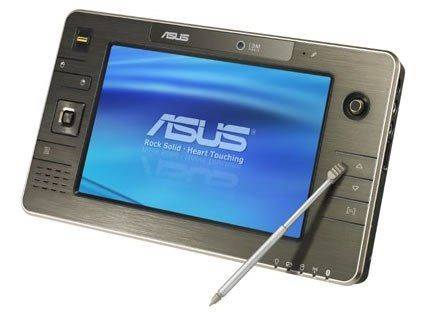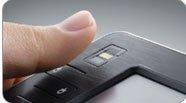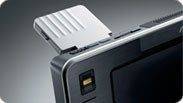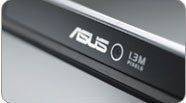 There are two choices open to you when you are confronted with a slate style UMPC. You can scratch your head and say, “there don’t be no keyboard here.” Or you can ask yourself, “how well can I use this despite the absence of a keyboard?” I asked myself the latter question when first confronted with the R2. This wasn’t the review unit, the R2E, I had for two weeks recently but the original R2H that was shown as one of the very first ultra mobile PC devices nearly three years ago. Not having a keyboard seems like a big compromise for any computer because it is the second most used part of any computer, after the mouse. Not having a keyboard bars you from doing most things you would normally do with your computer. And what use is a ultra mobile PC that does not even allow you to complete you daily computer routine? If all you want from your ultra mobile PC purchase is that it allows you to do what you already do on computers in a conveniently portable package than you probably won’t be excited by the prospect of a slate style UMPC. I however want a ultra mobile PC to go beyond my normal needs and perform different tasks. I therefore was excited by the R2H. [Read on…]
There are two choices open to you when you are confronted with a slate style UMPC. You can scratch your head and say, “there don’t be no keyboard here.” Or you can ask yourself, “how well can I use this despite the absence of a keyboard?” I asked myself the latter question when first confronted with the R2. This wasn’t the review unit, the R2E, I had for two weeks recently but the original R2H that was shown as one of the very first ultra mobile PC devices nearly three years ago. Not having a keyboard seems like a big compromise for any computer because it is the second most used part of any computer, after the mouse. Not having a keyboard bars you from doing most things you would normally do with your computer. And what use is a ultra mobile PC that does not even allow you to complete you daily computer routine? If all you want from your ultra mobile PC purchase is that it allows you to do what you already do on computers in a conveniently portable package than you probably won’t be excited by the prospect of a slate style UMPC. I however want a ultra mobile PC to go beyond my normal needs and perform different tasks. I therefore was excited by the R2H. [Read on…]
Vista
I will start by discussing the one topic I cannot avoid but shouldn’t have to talk about, Vista. I do this to get it out of the way so I can talk about the things that are good about the R2E. Much of the criticism I have of Vista on the R2E has already been talked about again and again but I would be remiss if I failed to mention them here.
The problem is two-fold. First, Vista consistently, annoyingly, constantly and carelessly uses system resources to do …something. It is thrashing the hard disk, freezing your system for reasons unknown. This isn’t just indexing of the hard drive, that was already done. And for me that is the most infuriating thing about the affair. I don’t mind that the OS is using some downtime for maintenance but I want to know what it is doing and most of all I want it to stop when I want to use the computer. It is my computer after all. Whatever Vista is doing when it is doing its thing interferes with what you want to be doing. No matter if you are trying to open a website, watch a movie, write something in Word or scroll down a page and Vista prevents you from doing this because it decides its needs are greater than yours and that is just inexcusable. The system boots to desktop in about 1 minute and 40 seconds which isn’t that bad but Vista is far from loaded and ready to use at that stage. It takes at least another 20 seconds to load up Internet Explorer and even than the system hasn’t settled down. This does eventually happen but it takes many minutes for that to happen. I am currently using an Everun S6S as my own ultra mobile PC and that has a very slow CPU combined with an even slower Flash hard drive. But it is only slow when it is doing something I want it to do. It never freezes the system because it decides, on its own, that its needs outweigh mine. I will leave this at that because this has all been said before and Vista isn’t ASUS’s fault. I will move on to something that is. The second problem is lack of RAM. ASUS has soldered 1GB of RAM onto the R2E main board and that, on its own, creates two problems. We all know 1GB isn’t enough. Vista will run on 1GB but it constantly needs to use virtual memory and that means accessing the hard drive. With over 21MB/s read and 17MB/s write speeds this slows down an already slow system. The RAM memory is so constricted that literally anything you do is accompanied by a read action from the hard disk and a momentary pause before your command is acted upon. And when I say literally anything that is exactly what I mean. Opening the start menu requires accessing the hard drive, so does switching between windows and even hovering over a button in word to get a tool tip.

The worst of that is though, that the RAM cannot be upgraded. With RAM prices what they are now I would gladly pay that little extra to get enough RAM to run Vista but ASUS has decided that isn’t going to be possible as they have not fitted a RAM slot and they don’t offer a 2GB option. 2GB would mean a huge difference in the usability of the system. Now you are limited to one or at the most a very few programs running at once. 2GB would solve that problem fully and I don’t understand why ASUS is not offering that option.
McCaslin
One of the few differences between the R2E and its predecessors is the hardware platform used. McCaslin is Intel’s first purposely designed ultra mobile PC platform, focusing on reducing watt usage and thereby increasing battery life. This has had its desired effect. While the R2H would struggle to reach 2 hours even under ideal conditions using the 2 cell battery. The R2E has a battery life of slightly over two hours with WiFi on. Pushing the CPU by, for instance, watching a movie will dip that figure a little but it never dropped below 2 hours on a full charge. On power saving the maximum battery life you can have is 2.5 hours. The extended 4 cell battery almost doubles those figures. To put a percentage on it, the R2E adds 20-25% battery life over the R2H. That is an impressive number but it needs to be remembered that Samsung managed to get a 3.5 hour battery life on the same platform with the smaller of the two battery options on their Q1 Ultra. I’m left with the feeling that there could have been an even longer battery life on the R2E has ASUS chosen more battery efficient peripheral components.
The A110 CPU in the R2E is more or less comparable in speed to either the Celeron 900MHz in the R2H or the P-M 1GHz in the R2Hv but the chipset is different. The R2E has a down clocked GM945 rather than the GM910. The most notable difference between the two is that the GM945 allows Vista’s Aero features to be enabled. UMPCPortal has shown how the McCaslin platform does an excellent job of running even high bit rate movie files. On the R2H certain codecs proved too much for the hardware and the playback became jerky or stalled altogether. I haven’t run into such issues on the R2E.
The A110 is known for creating a lot of heat when running full tilt and this does also happen on the R2E but I never found the heat to be a real problem. In fact the R2E runs cooler than the R2H and the fan noise, although audible is less loud as well.
I ran Crystalmark under two different power profiles. “High performance” and “power saving” lead to very different results as can be seen below. First up “High Performance”.
|
Total |
14007 |
|
ALU |
2856 |
|
FPU |
3030 |
|
MEM |
2551 |
|
HDD |
2622 |
|
GDI |
1681 |
|
D2D |
761 |
|
OGL |
506 |
And “Power Saving”.
|
Total |
11531 |
|
ALU |
2052 |
|
FPU |
2244 |
|
MEM |
2212 |
|
HDD |
2456 |
|
GDI |
1568 |
|
D2D |
621 |
|
OGL |
378 |
As can be noted from the numbers above both the CPU and GPU are down clocked in battery saving mode leading to a significant and noticeable decrease in performance. System freezes become more common and last longer, I would not recommend using this mode unless you are continuously working in a single program, for instance working in Word.
The performance deficit between the two modes means that Vista’s performance (or lack thereof) is not solely due to the paltry 1GB RAM but the limited CPU power also contributes to the general slowness of the system. This is something I had not before considered.
Productivity
The screen is very bright and because of that easy to read from even in bright rooms. Although direct bright sunlight does wash out the screen under any other condition the R2E is usable. The screen resolution does present a problem. At 800×480 the screen provides too little real estate to be considered adequate. At 7″ there is little reason not to use a 1024×600 resolution. Of course the R2E can interpolate to 1024×600 and it does an adequate job of it. Better than on the R2H both in terms of picture quality and the time it takes to change resolution. But this solution is far from perfect.
Vista might not be the best operating system choice from a performance perspective but when the system finally does settles down and your one program is loaded it starts to make a little more sense. Handwriting recognition is close to perfect. Under XP Tablet Edition handwriting was usable but required frequent corrections. Vista’s handwriting recognition makes using it second nature. Although I would not write a long piece like this review with it, editing pieces or writing forum posts using this method works well. Vista also supports many more languages, including Dutch, than did XP Tablet Edition. The R2E is such a good writing tool not just because of the features of Vista but also because of the rare addition of a heavy touch screen. Most UMPCs are equipped with a soft touch screen that requires only a light caress of the screen to register a touch. Good for finger navigation but once you try and write on the screen your palm will doubtlessly set off the screen causing vectoring issues and an unworkable writing experience. ASUS uses heavy touch screens that require much firmer pressure in order to register a touch. This means your palm wont set it off unfortunately neither will your finger, Pressing with a fingernail should work but for some reason I had trouble using the touch screen with even this method. It could just be me no longer being used to using this method since I got rid of my R2H or the touch screen on the R2E is even heavier than the one in the R2H. I didn’t have the R2E long enough to get comfortable with using the touch screen for navigation.



OneNote in particular shows the added benefits of a heavy touch screen. I use this program for two tasks, taking notes in classes and annotating research papers. While finger(nail) navigating is difficult the screen has no problem registering the strokes of the stylus pen ASUS provides with the R2E. It is an extendable stylus but a very good one. Both because of the length when extended and the fact the tip of the stylus is thickened it feels very much like using a pen rather than a stylus. I had no problems taking notes for extended periods of time. I would still prefer to have a real pen like I do on my R1F Tablet PC but given the size restrictions on a ultra mobile PC this is a very good second choice.
GPS and HSDPA both are semi unique features of the R2E and extend its potential. Microsoft Auto route is provided as software solution for use with the GPS. It’s functional but Spartan and complicated to work with. I haven’t been led astray because of it but it has told me to make a turn right into a building. If you plan on using this as your GPS solution I would recommend finding a program that is more comfortable to work with. You also need to find a way to mount the R2E in your car as one is not provided as standard but then I wouldn’t have expected it to be. On a good note the volume level of the R2E is greater than that of the R2H. With the R2H I was often unable to hear instructions even with the volume at its highest setting. This should be far less of a problem with the R2E. Touch navigation is a problem however. The heavy touch screen becomes a drawback here as the last thing you want to do while driving a car is have to focus on whether or not you have pressed your finger nail firmly enough against the screen.
HSDPA is perhaps the more exciting of the two features. It does away with the time consuming task of finding a WiFi hot spot or the annoyance of having to connect your mobile phone to access the internet. The sim card slot is located under the a latch that can only be opened with a screwdriver. The latch itself is located below the battery. Perhaps not the most convenient way change your sim card and definitely something to keep in mind if you need to change your Sim card on a regular basis. HSDPA is useful under any mobile situation but costly. Not only does it drive up the cost of the device itself it also adds a monthly cost for your data plan. In Netherlands the cheapest plan still costs €20 a month for 11KB/s. For high speed internet you need to pay €60 a month.
Entertainment
When watching movies the low screen resolution is not as much of a problem and the R2E becomes a very good movie player. With the SD reader supporting SDHC there is no problem getting even large files or groups of files on the R2E. In fact it is very convenient. Unlike on the R2H this SD reader is hot swappable so there is no need to un-mount every time you want to take the card out of the reader. Transfer speed testing was limited by my SD card which is not very quick. I am able to say that I did not run into severe limits like there are on the U1010/U810. The R2E has enough CPU power to handle all Internet video as well although that is hardly surprising.
I didn’t get around to doing much gaming. The restricted RAM would make running games difficult. Older games will run but this was true of the R2H as well. The improved graphics option should make running slightly less old games easier but these invariably also require more RAM to work, which the R2E doesn’t have in abundance. The one game I was planning on installing, Civilization 4, I didn’t have the heart to try. It ran with very low frames per second on the R2H but that was with plenty of RAM. Gaming isn’t going to be the first reason for anyone for buying a ultra mobile PC and that is a good thing. UMPCs don’t make good gaming devices and the R2E is no exception in this, which I find a pity.
Internet Surfing is a pleasure on the R2E. In large part this is due to the placement of the controls. The mouse nubbin on the right and mouse buttons on the left are perfectly placed. I found that I didn’t use the touch screen after a while as using the hardware controls is more convenient. Whether on the couch or in bed grabbing the R2E and watching a movie or surf the internet is a pleasant experience. More pleasant than when having to rest a keyboard on your lap. Unfortunately this is only true with the 2 cell battery. When the 4 cell battery is attached the whole thing becomes too bulky in my experience. It was fine when I was working on it and the R2E was laying flat on a table but when I need to hold it in my hands with the 4 cell battery it is just a little too heavy and a little too big to be comfortable.

Gripes and issues
I was only able to test the R2E for two weeks but in those two weeks I did run into a few issues. Annoyingly, after updating Vista the screen wouldn’t change resolution anymore. This was probably a driver issues that could have been fixed with reinstalling the proper driver but a Windows update shouldn’t cause a problem like this in the first place. I also had two issues with the WiFi. Although the problematic WiFi of the R2H is gone the R2E still doesn’t excel in WiFi strength. I was able to use it all around my house but the signal strength was weaker than with other devices I use. There was also a Vista issue that suddenly cuts WiFi off completely. Only a full reboot allows me to reconnect after this has happened. I have the same issue with my R1F Tablet PC which also runs Vista but not with any computer running XP. After installing SP1 for Vista instances of this have strongly diminished but not completely gone away.
Price
As jam packed with features as the R2E undeniably is you also pay for those features. The cheapest price for this ultra mobile PC in the Netherlands is a tad under €1000 at the moment. That is not cheap by any standard. Do you really need all those features? If you never plan on using HSDPA there is little use in paying the €200 premium for getting it. The 100GB storage on the current model can always be put to good use but do you want to pay for it? The same goes for GPS as well. If only the R2E was cheaper by about €200-300 it would be almost a no-brainer but now it is competing with likes of the HTC Shift and the Q1 Ultra Premium and although the cheapest of the three it is looking a little pale in the comparison. The R2E is not as fast as the Q1U Premium nor can it match its battery life. It doesn’t offer the keyboard or small form factor of the HTC Shift all the R2E is left with is its GPS and a heavy touch screen.
Pulling the trigger now?
Once you have decided the R2E is the best choice for you, you are presented with another question. At the time of this review the R2E isn’t new to the market and its successor, the Atom based R70, is already on the horizon. This raises the question whether to purchase now or wait a few months to buy the R70 which offers the same features but a higher resolution screen and a slightly improved battery life in a much smaller package? Answering that question can only be done on an individual basis but it will not be easy to answer. Apart from the differences mentioned above two of the main gripes of the R2E, its limited CPU speed and only 1GB RAM are also present on the R70 which also runs Vista with no other OS option having been mentioned. It’s not know whether upgrading the RAM is possible on the R70 and that may be the deciding factor in a purchasing decision.
Conclusion
The R2E is the proverbial jack of all traits. It can be employed in a wide variety of situations and for a wide variety of tasks. It is sturdy and seems well constructed for the mobile environment for which it is intended. The R2E is also expensive, has too little RAM and is too slow to run Vista comfortably. If you are looking for a digital writing tablet with HSDPA the R2E should be at the top of your list but if you have lower needs or ambitions for your ultra mobile PC you can get better value for money elsewhere.
External links and a full specifications set in the UMPCPortal product database.
[Sorry about the lack of ‘live’ photos on this review. We had to give the device back before we had a good chance to do the photo set.]











the correct expression is “jack of all trades”.
As Thorsten is Dutch i’m more than happy to forgive him that.
Informative review. But, it is clear that vista can make any UMPC suck :/
lol – classic!